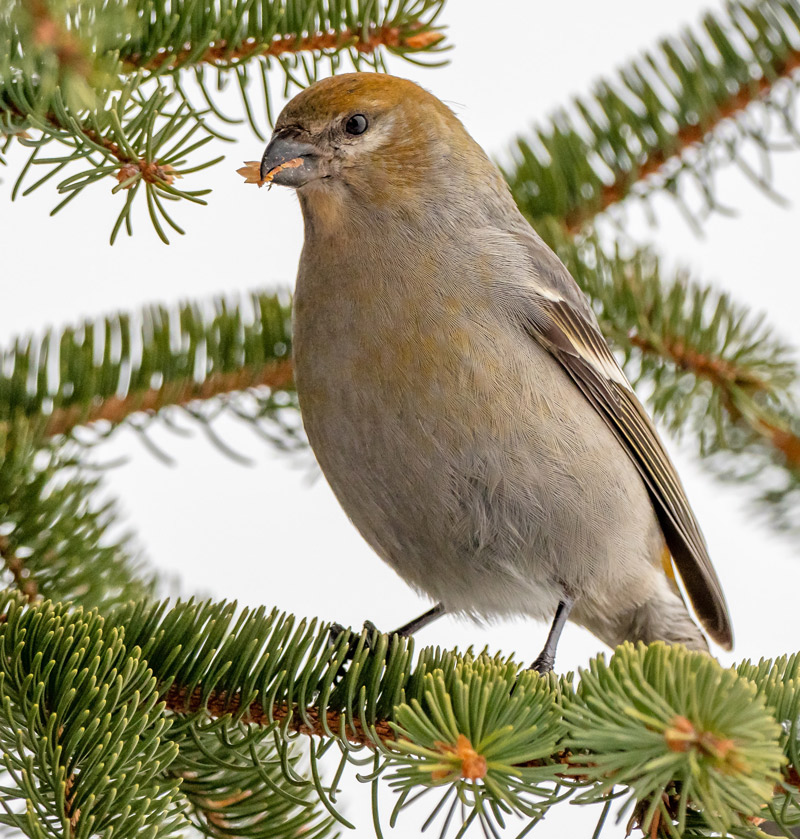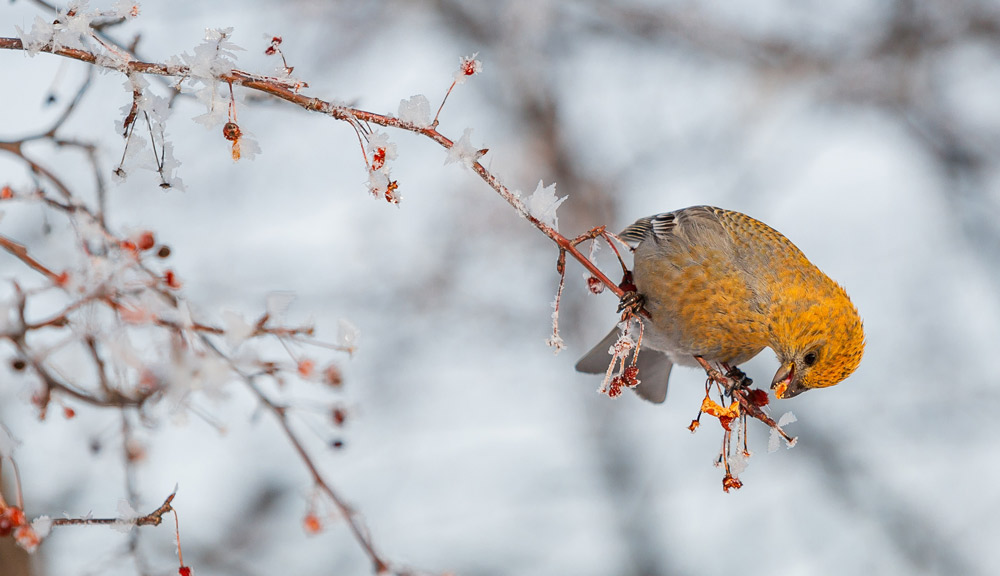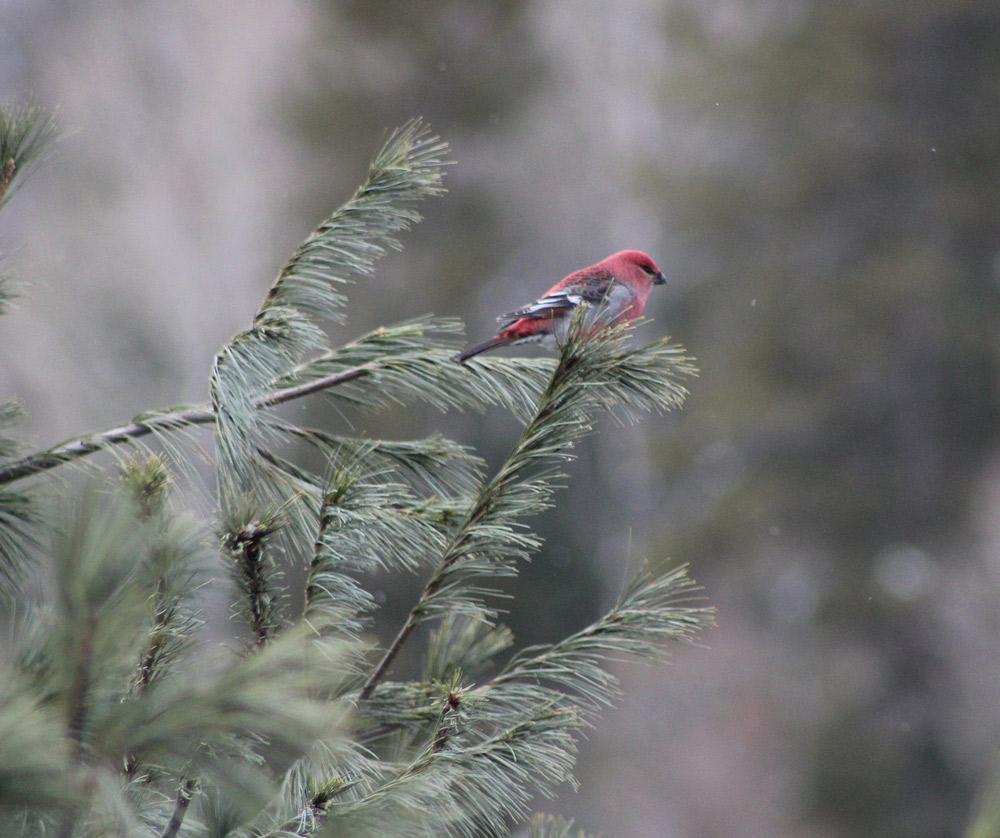PINE GROSBEAK, BIRDS, SOUND, RANGE, IMAGES, CALL, VIDEO, HABITAT, WINTER, USA, CANADA, QUÉBEC, ON
As winter blankets the northern forests with snow and ice, a colorful visitor from the north makes its way southward. The Pine Grosbeak, a plump, brightly colored bird, is on the move, searching for food and shelter in the depths of winter.
APPEARANCE AND HABITAT
To begin with, the Pine Grosbeak is a medium-sized bird, roughly the size of a robin, with a plump body and a large, cone-shaped bill. The males are a striking rosy-red color, while the females are a more subdued yellowish-olive with a gray head. Both sexes have distinctive white wing bars and a white patch on their tail.
It is a boreal bird, meaning it is found in the northern forests of North America and Eurasia. It is often associated with coniferous forests, where it feeds on the seeds of trees such as spruce, pine, and fir.
BEHAVIOR AND MIGRATION
During the summer breeding season, Pine Grosbeaks can be found in the high latitudes of Canada and Alaska, but as winter approaches, they begin to move southward in search of food. In some years, they may move as far south as the northern United States.
Pine Grosbeaks are nomadic birds, meaning they do not have a set migration pattern or winter range. Instead, they move in response to food availability, following the cone crops of trees such as spruce, pine, and fir. Pine Grosbeaks may remain in the north when these trees have a good cone crop, but in years with poor cone crops, they may move farther south in search of food.
DIET AND CONSERVATION
The Pine Grosbeak is primarily a seed eater, feeding on the seeds of coniferous trees. It also feeds on insects and fruit when available.
Although the Pine Grosbeak is not currently considered a threatened species, it faces habitat loss and climate change threats. As the climate warms, the range of the Pine Grosbeak may shift northward, putting it at risk of losing suitable habitat.
Nonetheless, the Pine Grosbeak relies on mature, old-growth forests for nesting and foraging. As these forests are harvested for timber or destroyed by natural disasters such as wildfires, the availability of suitable habitat for the Pine Grosbeak may decline.
BREEDING AND REPRODUCTION
During the breeding season, Pine Grosbeaks build nests in coniferous trees using twigs, grasses, and other plant material. The female lays 3-4 eggs, which she incubates for about two weeks. The chicks are fed by both parents and fledge after about two weeks.
Pine Grosbeaks are not particularly social birds, and they typically breed in solitary pairs or small groups. However, during the winter, they may form larger flocks to forage for food.
Male Pine Grosbeak
INTERACTION WITH HUMANS
While the Pine Grosbeak is not a common bird in most areas, it is popular among birdwatchers and enthusiasts. Its striking coloration and unusual behavior make it an interesting species to observe.
Indeed, the Pine Grosbeak is important to the forestry industry, as it feeds on the seeds of coniferous trees, which are an important commercial crop in many areas. However, Pine Grosbeak’s reliance on mature, old-growth forests means that it may be negatively impacted by logging practices that remove these forests.
CONSERVATION EFFORTS
As the Pine Grosbeak faces threats from habitat loss and climate change, conservation efforts are being undertaken to protect this species. These efforts include preserving old-growth forests, reducing greenhouse gas emissions to slow climate change, and monitoring Pine Grosbeak populations to better understand their behavior and movements.
Additionally, many organizations and individuals are working to raise awareness of Pine Grosbeak and the importance of protecting its habitat. By working together, we can ensure that this colorful and fascinating bird continues to thrive in the northern forests for generations to come.
WHAT IS THE LIFESPAN OF PINE GROSBEAK?
The lifespan of a Pine Grosbeak is relatively short compared to some other bird species, with the average lifespan being around 2-3 years in the wild. However, some individuals have been known to live up to 8 years in the wild. The lifespan of a Pine Grosbeak can be affected by factors such as predation, disease, and food availability, among other factors. In captivity, Pine Grosbeaks have been known to live up to 15 years.
WHAT’S THE SIZE OF A PINE GROSBEAK?
It’s a medium-sized bird, with an average length of 8-9 inches (20-23 cm) and a wingspan of 14-15 inches (35-38 cm). They weigh between 1.8-2.3 ounces (50-65 grams), with males typically being slightly larger than females. Their plump bodies and large, cone-shaped bills are characteristic of finch species, and they have a distinctive white patch on their tails and white wing bars.
HOW IS THE SOUND OF PINE GROSBEAK?
The Red Pine Grosbeak has a variety of vocalizations, including a series of musical whistles, chirps, and warbling notes. Their calls are generally sweet and melodic and can be quite complex. Males may sing a sweet, flute-like song during the breeding season. They are generally not considered to be highly vocal birds, and their songs and calls are often heard more frequently during the breeding season than during the winter months. Overall, the Pine Grosbeak has a pleasant and varied vocal repertoire, which adds to its appeal as a species for birdwatchers and bird enthusiasts.
RANGE OF PINE GROSBEAK?
This red bird is a widespread bird species that are found across northern regions of the Northern Hemisphere. Its range extends across northern Europe, Asia, and North America, and it is commonly found in boreal forests, taiga, and subalpine habitats.
In North America, the Pine Grosbeak’s range extends south of Alaska and northern Canada to the northern United States, with occasional sightings further south in winter. In Europe, it is found across Scandinavia and Russia, as well as in the northern mountains of Spain and the Pyrenees. The Pine Grosbeak is found across Siberia, Mongolia, and northern China in Asia.
The Red Grosbeak is generally considered to be a non-migratory species, although some individuals may move southward in winter if food is scarce in their normal range. The range of the Pine Grosbeak is relatively stable, although it may be affected by climate change and habitat loss in some areas.
WHEN IS THE BREEDING SEASON OF PINE GROSBEAK?
The breeding season of the Pine Grosbeak typically begins in late winter or early spring, depending on the location and climate. In its northern range, breeding may begin as early as February or March, while in more southerly areas, it may not begin until April or May.
During the breeding season, Pine Grosbeaks form pairs or small groups and begin to build their nests in coniferous trees using twigs, grasses, and other plant materials. The female lays 3-4 eggs, which she incubates for about two weeks. Both parents take turns incubating the eggs and feeding the chicks after they hatch.
Its breeding season is relatively short, lasting only a few months, and the young typically fledge after about two weeks. After the breeding season is over, Pine Grosbeaks may form larger flocks to forage for food, especially during the winter months.

HOW TO ATTRACT THE PINE GROSBEAK?
Attracting Pine Grosbeaks to your yard or bird feeding station can be a rewarding experience for birdwatchers and bird enthusiasts. Here are some tips on how to attract Pine Grosbeaks:
Provide the right food: Pine Grosbeaks feed on a variety of food sources, including seeds, berries, and insects. They are particularly fond of the seeds of coniferous trees such as spruce and pine, as well as the fruits of mountain ash and other berry-producing trees. To attract Pine Grosbeaks, you can offer them sunflower seeds, peanuts, or other seeds in a hopper or tube feeder. You can also provide them with fruit, such as sliced apples or oranges.
Offer fresh water: Pine Grosbeaks need access to fresh water for drinking and bathing. You can provide them with a bird bath or other shallow water source to attract them to your yard.
Plant the right trees and shrubs: Pine Grosbeaks are attracted to mature, old-growth forests, so planting coniferous trees such as spruce or pine, as well as berry-producing shrubs, can help to attract them to your yard.
Provide a comfortable habitat: Pine Grosbeaks prefer quiet, wooded areas, so it’s important to create a comfortable habitat for them by providing plenty of cover and shelter.
Be patient: Pine Grosbeaks are not always easy to attract to backyard bird feeders, so it’s important to be patient and persistent in your efforts. With the right food, water, and habitat, however, you may be able to attract these beautiful birds to your yard and enjoy watching them up close.
PINE GROSBEAK SCIENTIFIC NAME?
The scientific name for Pine Grosbeak is Pinicola enucleator. The genus name, Pinicola, comes from the Latin word “pinus,” which means pine, and “cola,” which means inhabitant. The species name, enucleator, comes from the Latin word “enucleare,” which means to remove the kernel, and refers to the bird’s habit of removing the kernels from pinecones. Together, the scientific name Pinicola enucleator reflects the bird’s close association with coniferous forests and its specialized diet of pine seeds.
FUN FACTS ABOUT PINE GROSBEAK?
Pine Grosbeaks are sometimes referred to as “grosbeaks on the rocks” because they are often found foraging on the ground near rocky outcroppings in the mountains.
Pine Grosbeaks are known for their love of fruit, and they have been observed getting “drunk” on fermented mountain ash berries.
Despite their relatively short lifespan, Pine Grosbeaks have been known to survive some extreme weather conditions, including temperatures as low as -40 degrees Fahrenheit.
Pine Grosbeaks have a unique digestive system that allows them to extract nutrients from a wide variety of seeds, including some that are toxic to other birds.
In some Native American cultures, the Pine Grosbeak symbolizes strength and resilience and is believed to bring good luck and prosperity to those who see it.
In conclusion, the Pine Grosbeak is a fascinating and beautiful bird that is found in the boreal forests of North America, Europe, and Asia. This species is known for its distinctive red plumage, a specialized diet of pine seeds, and melodious vocalizations. Although it is not a migratory bird species, Pine Grosbeaks may exhibit irregular movements in response to changes in food availability or other environmental factors.
Male and female Pine Grosbeaks can be distinguished by differences in size, coloration, bill size, and voice, and the species is known for its ability to survive in harsh and unpredictable northern climates. Overall, the Pine Grosbeak is a unique and interesting bird species that is well worth learning more about for bird enthusiasts and nature lovers alike.
WANT TO LEARN MORE? TAKE A LOOK AT THESE ARTICLES:
- The Scarlet Ibis
- The Scarlet Macaw
- Lovebirds
- The Female Cardinal
- The Great Egret
- The Great Blue Heron
- The American Robin
- The Northern Cardinal
- The Dark-Eyed Junco
- The Blue Jay
- The Gray Catbird
- The Tufted Titmouse
- The Red-winged Blackbird
- The Black-capped Chickadee
- The Evening Grosbeak
- The Common Starling
- The Kiwi Bird
- Wild Birds Unlimited




